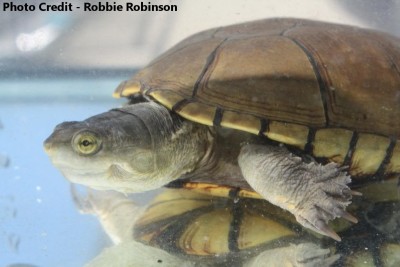Description and Identification
Kinosternon flavescens is a moderate-sized mud turtle. Males are typically slightly larger than females, usually reaching an SCL of 6-6.25” (max ~6.7”) – while females usually reach an SCL of 4-5” (max ~6”). The carapace is typically wide, smooth, and flattened on top. There is no vertebral keel and, instead, it is frequently depressed slightly down the midline. The coloration of the carapace can vary quite a bit among individuals of this species – ranging from various shades of yellow or brown to gray or olive hues. It is also not uncommon for their carapaces to have a somewhat dense carpet of algae growing on it. The primary identifying features of the carapace are the wide anterior margins of the first vertebral scute – which extend to touch the second marginals – and the elevated ninth and tenth marginal scutes, which are noticeably taller than the surrounding marginals.
The plastron of Kinosternon flavescens is usually yellow or brown, with a darker brown found along the seams, and has two well-developed hinges at the front and rear borders of the abdominal scutes. The bridge is usually a dark brown as well. These turtles have fairly long necks, with bright yellow skin on their throats. The yellow throat may sometimes be speckled with gray – particularly in older males. One to two pairs of small fleshy barbels usually protrude from the underside of the turtle’s chin. Their heads are flattened, with a slightly protruding snout and an upper jaw that is sometimes hooked – also, more so in males. They have strong limbs and all four feet are webbed with relatively large claws.
The tails of both sexes are tipped with a terminal horny spur. Many texts inaccurately describe only the males as having a terminal spur – likely due to the fact that the tails spurs of females are often less conspicuous. Males have fairly pronounced concavity of the plastron and long, thick, spine-tipped tails that wrap along the back side of the body and protrude well beyond the posterior carapace margin. Males also have a patch of rough scales (clasping organs) on the posterior, inner surface of each hind leg. Females have much smaller, spine-tipped tails and lack the patches of rough scales on their hindlegs.
The carapace of hatchlings is more circular than that of the adults, has a yellow margin with a dark speck at the posterior border of each scute, and may have a very slight keel. The 9th and 10th marginals of hatchlings are even with the surrounding marginals and do not become elevated until the turtle is larger (SCL ~2.6”).
-
 Primary ID: Wide anterior margins of 1st vertebral scute extend to touch 2nd marginalPrimary ID: Wide anterior margins of 1st vertebral scute extend to touch 2nd marginal
Primary ID: Wide anterior margins of 1st vertebral scute extend to touch 2nd marginalPrimary ID: Wide anterior margins of 1st vertebral scute extend to touch 2nd marginal -
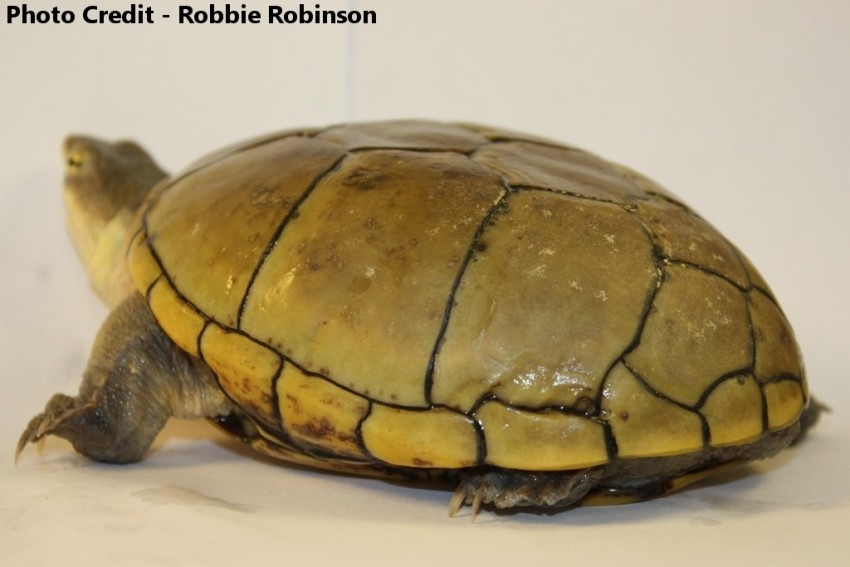
-
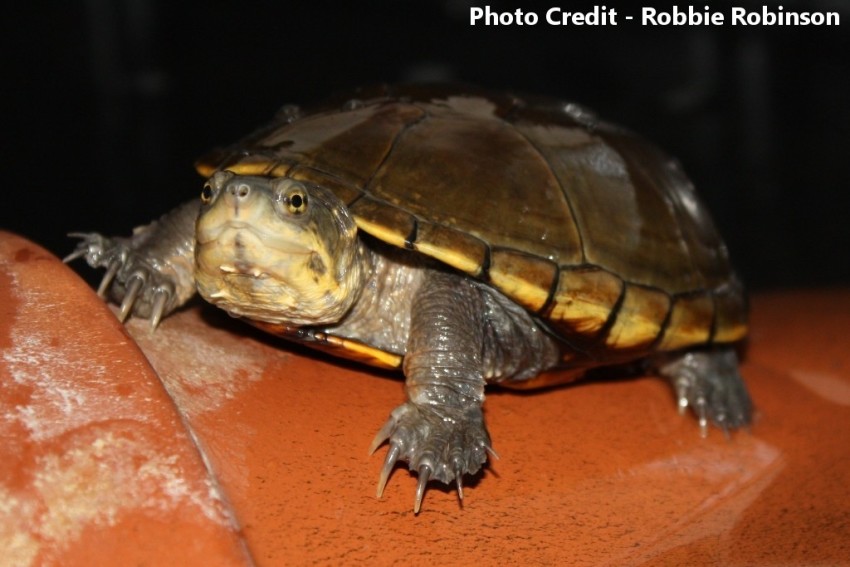 Note the fleshy barbels protruding from the underside of the chinNote the fleshy barbels protruding from the underside of the chin
Note the fleshy barbels protruding from the underside of the chinNote the fleshy barbels protruding from the underside of the chin -
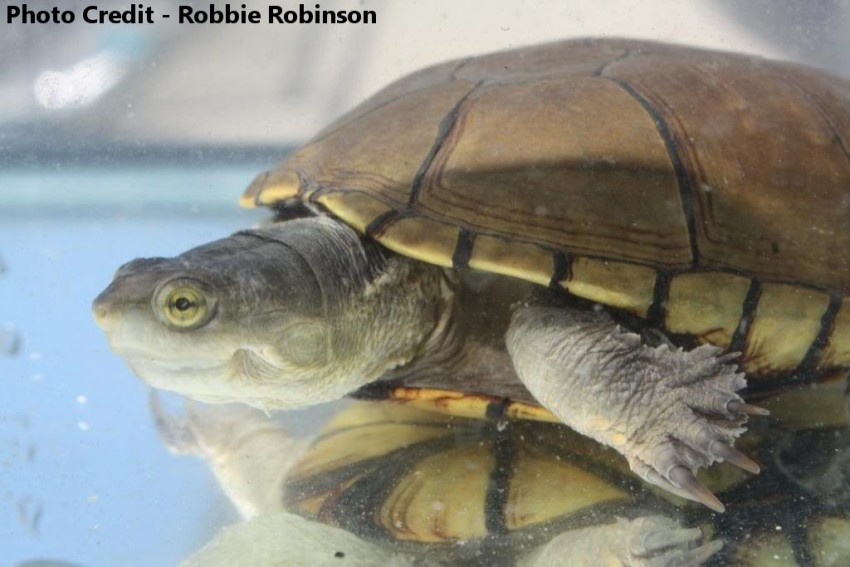
-

-

-
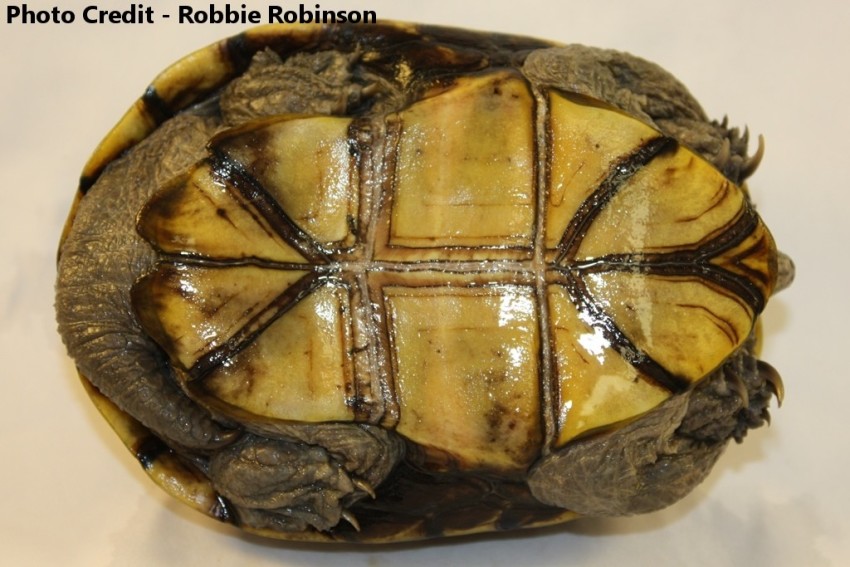 Plastron: Has two well-developed hinges at the front and rear borders of the abdominal scutesPlastron: Has two well-developed hinges at the front and rear borders of the abdominal scutes
Plastron: Has two well-developed hinges at the front and rear borders of the abdominal scutesPlastron: Has two well-developed hinges at the front and rear borders of the abdominal scutes -
 Front: Wide anterior margins of 1st vertebral scute extend to touch 2nd marginalFront: Wide anterior margins of 1st vertebral scute extend to touch 2nd marginal
Front: Wide anterior margins of 1st vertebral scute extend to touch 2nd marginalFront: Wide anterior margins of 1st vertebral scute extend to touch 2nd marginal -

-
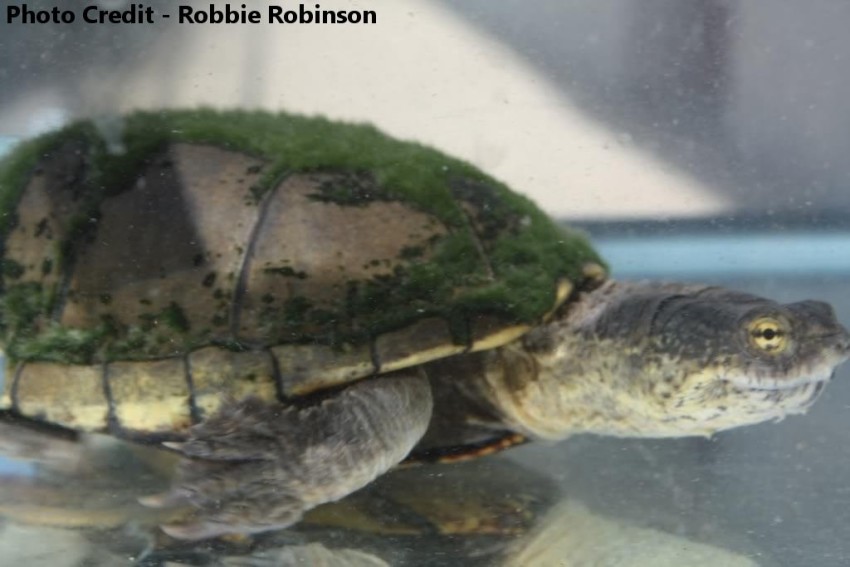
-
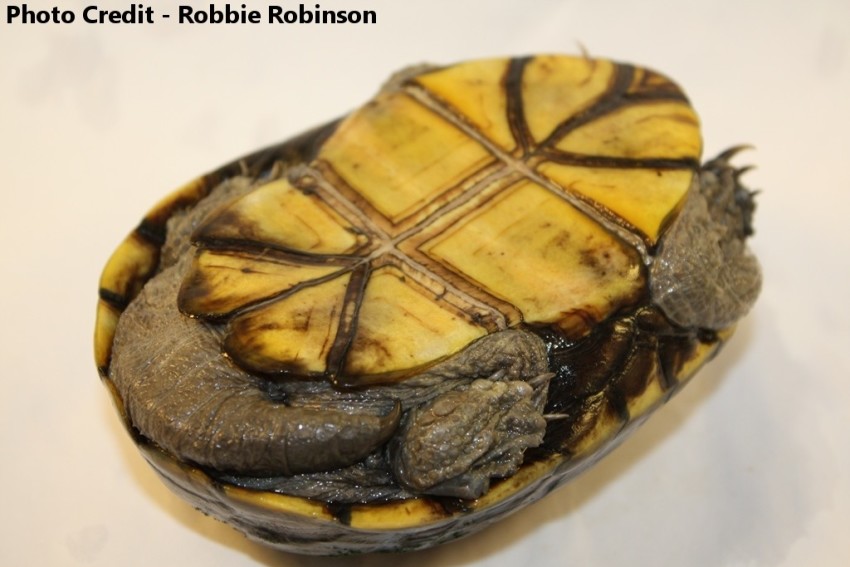 Note the terminal horny spur at the tip of this large maleu2019s tailNote the terminal horny spur at the tip of this large maleu2019s tail
Note the terminal horny spur at the tip of this large maleu2019s tailNote the terminal horny spur at the tip of this large maleu2019s tail
Distribution
The Yellow Mud Turtle can be found in a wide range of territories covering the central and southwestern United States and northern Mexico. In the US, it is native to the Great Plains region – including Southern Nebraska, Kansas, Oklahoma, Texas, and New Mexico – and extends into southeastern Arizona as well. Isolated populations also exist in Illinois, Iowa, and northeastern Missouri. In Mexico, it can be found in the states of Sonora, Chihuahua, Coahuila, Durango, Nuevo León, Tamaulipas, and down into northern Veracruz.
Native Habitat
Kinosternon flavescens is primarily found in desert and prairie grassland environments where it inhabits shallow, often temporary, bodies of water with soft, sandy or muddy bottoms. However, it can be found in almost any form of slow-moving body of water throughout its range – such as streams, rivers, oxbow lakes, sinkholes, wetlands, swamps, cattle tanks, and even ditches or canals.
Wild Diet
Yellow Mud turtles are omnivorous and opportunistic feeders. While they do eat some aquatic plants, their diet consists primarily of insects, crustaceans, mollusks, amphibians, fish, carrion, and earthworms. They almost always feed underwater, but there are several reports that they have been seen eating on land as well as a few studies that have demonstrated that some yellow mud turtles will feed on earthworms while buried underground.
Behavior
Yellow Mud turtles are relatively shy – spending the majority of their day basking or hidden, scavenging among aquatic vegetation. When handled they hardly ever bite, but are often very quick to emit a pungent musk when they feel threatened.
Kinosternon flavescens is remarkably adapted to the ever changing and often harsh conditions of the desert and prairie grassland terrains it inhabits. Particularly in the southern extent of its range, it undergoes periods of terrestrial estivation – burying itself up to 10” deep in sandy soil – during times of drought and the hottest parts of midsummer. During particularly harsh years, the summer estivation may continue directly into the winter hibernation – with the turtle remaining dormant and underground from midsummer through the following spring. Some years they may only be active long enough to mate and lay eggs before going dormant once again.
Yellow Muds have a relatively large activity range when compared to other Kinosternidae species as they frequently migrate great distances over land from one body of water to another. This movement is often triggered by rainfall – and in some parts of their range, numbers of them may be seen crossing roads following a heavy downpour.
Kinosternon flavescens spend the colder months hibernating in loose soil, brushpiles, mud at the bottom of ponds, or various forms of natural depressions such as old burrows, muskrat dens, and stumpholes.
Reproduction
Males typically reach sexual maturity at an SCL of 8-9cm (3.1-3.5”) – usually at around five or six years old. Females reach sexual maturity at about 8-12cm (3.1-4.7”) – which may take anywhere from four to sixteen years in the wild. Studies have demonstrated that size – rather than age – is the more important determinant of sexual maturity.
Mating usually occurs in April and May – although it may occur at any part of the year in more southern parts of its range – and is often stimulated by rainfall. Courtship takes place primarily in the water and often follows a predictable pattern of behaviors. It usually begins with the male chasing the female, nudging her around the tail, and often biting near her head. Once the male catches and mounts the female, he will position his plastron directly over her carapace and, using the claws of all four feet, grasp the edges of the female’s carapace. Throughout copulation – which may last anywhere from a few minutes to a few hours – the male will continually stretch out his neck and bite and rub the female’s head, often puffing up his throat.
Nesting typically begins in May and peaks in June – with only about 75-95% of females nesting in a given year. Particularly harsh years may result in less than 50% of the females nesting. Females may travel relatively long distances away from water to find ideal nesting sites. Once she has decided on a nest site, she will dig a nest, usually releasing bladder water to soften the soil/sand, and lay her eggs 17-23cm (6.7-9”) below the soil’s surface.
Nesting females in Nebraska have been reported to sometimes show a very unique pattern of maternal behavior. During times of reduced rainfall and extreme drought, the female will often bury herself with her eggs, and remain with the nest, dampening the soil with her urine, for 1 to 40 days before digging out of the ground and returning to water – with some females not returning to the water until the next spring. Kinosternon flavescens is the only species of turtle that has been reported to burrow underground and remain with its nest for any length of time longer than that required to cover the nest.
Clutches contain one to ten (typically two to six) hard, elliptical eggs. In most northern populations, females lay only one clutch each year. Females from southern populations may occasionally nest twice a year – although it has been suggested that this occurs when the female divides a single clutch and deposits eggs in two nests.
Kinosternon flavescens exhibits TSD-amb. Eggs incubated at 24–28°C (75.2-82.4°F) yield a higher proportion of males, while those incubated at 29-31°C (84.2-87.8°F) yield mostly females. Eggs hatch in the fall – after an incubation period of 94- 125 days – and hatchlings will usually overwinter in the soil near the nest, before migrating to water in the following spring.
This Care Guide is an external Care Guide. While it is possible this care guide may not be for the exact species you were looking for, it provides information suitable for your species. This Care Guide link will take you away from theTurtleRoom. We only link to care guides we trust. Thanks for visiting theTurtleRoom.org.
Care GuideIf you would like to contribute to the photo gallery of any turtle or tortoise species, please email us at [email protected]. You will be credited for any photos you contribute.
| Kinosternon flavescens |
| (Agassiz, 1857) |
| IUCN Red List: |
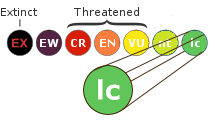 |
| Least Concern (2011) |
| Order: | Testudines |
| Suborder: | Cryptodira |
| Superfamily: | Kinosternoidea |
| Family: | Kinosternidae |
| Subfamily: | Kinosterninae |
| Genus: | Kinosternon |
| species: | flavescens |
| Old Taxonomy: |
| Kinosternon flavescens spooneri |
| U.S. Legal Status: |
| Take illegal in Colorado, Iowa, Illinois, Kansas and Texas; Nebraska has a limit of 3. Can be taken with proper licensing in Arizona and New Mexico (bag limit of 20). Possession illegal in Colorado, Iowa, and Illinois; Nebraska has a limit of 3. |
Author:
Editors: Stephen J. Enders, Anthony Pierlioni, Chris Leone, Andrew S. Weber, Ben Forrest, and Andrew Hermes
Sources
Disclaimer: The Species Profiles - Natural History, Care Guide, and Photo Gallery database is an educational resource. It does not cover all Chelonian species in the world, nor does it include all the latest scientific information about the species covered. Though we edit our accounts for accuracy, we cannot guarantee all information in those accounts. While theTurtleRoom's staff and contributors provide references to books and websites that we believe are reputable, we cannot necessarily endorse the contents of references beyond our control.

This work by theTurtleRoom is licensed under a Creative Commons Attribution-NonCommercial-ShareAlike 4.0 International License.








































